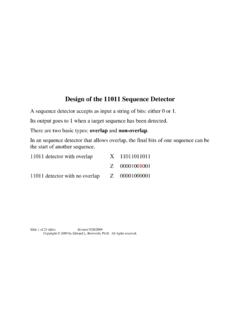Transcription of Binary Adders: Half Adders and Full Adders
1 Slide 1 of 20 slides September 4, 2010 Binary Adders : half Adders and full Adders In this set of slides, we present the two basic types of Adders : 1. half Adders , and 2. full Adders . Each type of adder functions to add two Binary bits. In order to understand the functioning of either of these circuits, we must speak of arithmetic in terms that I learned in the second grade. In the first grade, I learned by plus tables , specifically the sum of adding any two one digit numbers: 2 + 2 = 4, 2 + 3 = 5, etc. In the second grade, I learned how to add numbers that had more than one digit each: 23 + 34 = 57, but 23 + 38 = 61.
2 This adaptation of addition to multiple digit numbers gives rise to the full Arithmetic half Adder and full Adder Slide 2 of 20 slides September 4, 2010 Some Sample Sums, with Comments We begin with two simple sums, each involving only single digits. 2 + 2 = 4, and 5 + 5 = 10. If these are so, why do we write the following sum 25 + 25 as 25 + 25 = 50, and not as 25 + 25 = 4 10? What digit is written in the unit s column of the sum? The reason that we do not do this is the idea of a carry from the unit s column to the ten s column. In the language of the second grade, we describe the addition as follows: 1.
3 5 + 5 is 0, with a carry out of 1, which goes into the ten s column. 2. 2 + 2 is 4, but we have a carry in of 1 from the unit s column, so we say 2 + 2 + 1 = 5. The sum digit in this column is a 5. Binary Arithmetic half Adder and full Adder Slide 3 of 20 slides September 4, 2010 Positional Notation in Arithmetic In standard decimal arithmetic, the number 25 is read as twenty five , and represents 2 10 + 5 1: two tens plus five ones. Remember that the only digits used in Binary numbers are 0 and 1. In Binary arithmetic, the number 10 is read as one zero , avoiding the names we use for decimal numbers.
4 It represents 1 2 + 0 1. In Binary arithmetic, the number 101 represents 1 22 + 0 21 + 1 1, or 1 4 + 0 2 + 1 1 = 4 + 1 = 5. In all arithmetics: 0 + 0 = 0, 0 + 1 = 1, and 1 + 0 = 1. In decimal arithmetic: 1 + 1 = 2. In Binary arithmetic what is 1 + 1? Binary Arithmetic half Adder and full Adder Slide 4 of 20 slides September 4, 2010 The Sum 1 + 1 in Binary Arithmetic We have just noted that the decimal number 2 is represented in Binary as 10. It must be the case that, in Binary addition, we have the sum as 1 + 1 = 10 This reads as the addition 1 + 1 results in a sum of 0 and a carry out of 1.
5 Recall the decimal sum 25 + 25. 1 2 5 2 5 5 0 The 1 written above the numbers in the ten s column shows the carry out from the unit s column as a carry in to the ten s column. Binary Arithmetic half Adder and full Adder Slide 5 of 20 slides September 4, 2010 Binary Arithmetic half Adder and full Adder Slide 6 of 20 slides September 4, 2010 The half Adder The half adder takes two single bit Binary numbers and produces a sum and a carry out, called carry . Here is the truth table description of a half adder. We denote the sum A + B.
6 A B Sum Carry 0 0 0 0 0 1 1 0 1 0 1 0 1 1 0 1 Written as a standard sum, the last row represents the following: 01 + 01 10 Binary Arithmetic half Adder and full Adder Slide 7 of 20 slides September 4, 2010 The sum column indicates the number to be written in the unit s column, immediately below the two 1 s. We write a 0 and carry a Arithmetic half Adder and full Adder Slide 8 of 20 slides September 4, 2010 The half Adder and the full Adder In all arithmetics, including Binary and decimal, the half adder represents what we do for the unit s column when we add integers.
7 There is no possibility of a carry in for the unit s column, so we do not design for such. Another way is to say that there is a carry in; it is always 0. The full adder in decimal arithmetic would be used for the other columns: the ten s column, the hundred s column, and so on. For these columns, a non zero carry in is a distinct possibility Considered this way, we might write our sums table as follows. 2 + 2 = 4, if the carry in is 0, and 2 + 2 = 5, when the carry in is 1. Admittedly, the complexities of decimal arithmetic suggest another way, just add the values as three numbers, here 2 + 2 + 1 = 5.
8 Binary Arithmetic half Adder and full Adder Slide 9 of 20 slides September 4, 2010 Implementing the half Adder Here again is the truth table for the half adder. A B Sum Carry 0 0 0 0 0 1 1 0 1 0 1 0 1 1 0 1 We need equations for each of the Sum and Carry. Because we have used a truth table to specify these functions, we consider Boolean expressions. Note that the carry is the logical AND of the two inputs: Carry = A B. The sum can be given in two equivalent expressions. The simplest expression uses the exclusive OR function: Sum = A B. An equivalent expression in terms of the basic AND, OR, and NOT is: Binary Arithmetic half Adder and full Adder Slide 10 of 20 slides September 4, 2010 Circuits for the half Adder Here are two slightly different circuit implementations of the half adder.
9 The circuit on the left implements the sum function as Sum = A B. The circuit on the right implements the sum function as Binary Arithmetic half Adder and full Adder Slide 11 of 20 slides September 4, 2010 Implementing the full Adder Here we show the truth table for the sum of A and B, with carry in of C. A B C Sum Carry 0 0 0 0 0 0 0 1 1 0 0 1 0 1 0 0 1 1 0 1 1 0 0 1 0 1 0 1 0 1 1 1 0 0 1 1 1 1 1 1 To read this as decimal, pretend that the Sum is Sum_Bit and read as the Decimal_Sum = Carry 2 + Sum_Bit. Binary Arithmetic half Adder and full Adder Slide 12 of 20 slides September 4, 2010 So 1 + 1 + 0 = 1 2 + 0 = 2 (decimal), and 1 + 1 + 1 = 1 2 + 1 = 3 (decimal).
10 One Circuit for the full Adder Here is the traditional AND/OR/NOT circuitry for the full adder. Binary Arithmetic half Adder and full Adder Slide 13 of 20 slides September 4, 2010 The full Adder with C = 0 Binary Arithmetic half Adder and full Adder Slide 14 of 20 slides September 4, 2010 The circuit above implements the following two expressions, where C is the carry in to the full adder. Sum = A B C + A B C + A B C + A B C Carry = A B + A C + B C Suppose we let the carry in C = 0. Then C = 1. What we have then is as follows. Sum = A B 0 + A B 1 + A B 1 + A B 0 = A B + A B Carry = A B + A 0 + B 0 = A B As expected, a full adder with carry in set to zero acts like a half adder.







